Blazing Kernel for JB 4.1.2 & 4.2.2
XDA Thread: Link
Downloads
Ho yeah!!! I finally made it! A kernel similar to Siyah kernel! You can use this on AOSP 4.2.2 ROMs or stock Sammy 4.1.2 ROMs, it will work in both! Plus, using a similar dual booting method like what fuss132 did, you can now dual boot stock+stock, AOSP+AOSP or stock+AOSP!
Features
AOSP & Stock Features:
- Can be flashed directly using stock recovery!
- Supports DUAL BOOTING
- Compiled using CM source
- Compiled using Linaro toolchain 4.7.3
- Linux kernel version 3.0.60
- 2 versions of recovery available (different zImage): TWRP and CWM!
- Default scheduler is cfq
- Default governor is interactive
- MMC_CAP_ERASE already disabled by Samsung -> no more brick bug
- Supports CIFS
- USB fast charge (use an app called “Fast Charge” to toggle)
- Custom voltage settings (use “Voltage Control” to set)
- Frandom support!
- Patched /dev/random
- More RAM (original=769 MB, Blazing Kernel=774MB)
- Additional governors: HYPER, Scary, wheatley, abyssplug, minmax, lulzactive, lazy, pegasusq, lagfree, smartassV2
- Addtional I/O schedulers: vr, sio, row
- swap support
- zRAM support
- exFAT module support
- Dynamic Fsync
- Dynamic Dirty Page Writeback
- Battery Life eXtender (BLX)
- Miscellaneous tweaks
Stock only features:
- Custom bootanimation (just place bootanimtion.zip in /system/media; to restore original bootanimation, just delete the bootanimtion.zip in /system/media) [AOSP already has this]
- Custom boot sound (just place PowerOn.ogg in /system/media; to mute, create an empty file named “mute” in /system/media; to unmute, create an empty file named “unmute” in /system/media ; to restore original boot sound, create an empty file named “ori_sound” in /system/media)
- Init.d scripts support (Place scripts in /system/etc/init.d or /data/etc/init.d) [AOSP already has this]
Bugs
AOSP:
- Cannot control vibration intensity
Stock:
- Cannot control touchkey light duration or turn on/off
Requirements
- Running a stock 4.1.2 Samsung ROM or stock 4.1.2 based ROM
- Running a AOSP 4.2.2 ROM
- At least 3 GB in internal storage if you want to dual boot
ROMs Supported
Basically ALL ROMs!
- stock Samsung ROMs [4.1.2]
- stock based ROMs [4.1.2]
- MIUI [4.1.2]
- CM 10.1 [4.2.2]
- CM 10.1 based ROMs [4.2.2]
- AOKP [4.2.2]
- AOKP based [4.2.2]
- AOSP based [4.2.2]
Instructions
Flash via stock or custom recovery (Safest and easiest method):
- Choose your recovery type: CWM6 or TWRP.
- Download the corresponding zip package.
- Place in sdcard (external sdcard for those running stock recovery)
- Flash the zip.
- Reboot. It may take a little while as the kernel has lots of things to configure.
Changelog
v11:
- Updated to Linux kernel 3.0.75
- BLX
- Dynamic Fsync
- Dynamic Dirty Page Writeback
- Dyanmic mutex spin management
- CRC32 algorithm
- Updated voltage control
- Latest sync with CM for better compatibility
- Fixed MTP not working in stock for certain people
- Philz recovery now available!
- Compiled using Linaro 4.7.4 toolchain
v10:
- Updated to Linux kernel 3.0.60 (this is a real update, applied patches step by step instead of skiping those in between
(there's one kernel that skipped most of the patches and went to 3.0.75 straight away lol, reverted the 3.0.76 and applied 3.0.77, and claims that it is on 3.0.77 now...lol...and I tried to advice him, but always ignored...:silly:))
- Fixed random reboots in recovery
- Removed interactiveX governor (main cause of the reboots)
- zRAM support (for fun...lol)
- swap support (for fun...lol)
- exFAT module support (sdcards can be formatted in exFAT format now)
- Compiled using Linaro 4.7.3 toolchain
v9:
- Initial dual base kernel commit
- Bring forward all features from v8
- Dual boot supportDual Booting
This feature requires extra attention, so please read carefully!
- Decide which ROM you want to place as secondary ROM. The most suitable ROM would be the one that has less updates and stable. Keep in mind that currently all secondary ROMs will start off clean, means ALL DATA WILL BE CLEARED, and /data is 1GB in size.
Now, decide between step 2 or 3: - If you decide to keep using the current ROM you are running as primary ROM, please make a FULL BACKUP now and skip to step 4.
- If you decide to use the current ROM as secondary and do not mind about data loss, please flash the latest kernel zip package now and skip to step 5.
- Since you decide to use another ROM as secondary ROM, AFTER making a backup, flash the other ROM. Then, flash the latest kernel zip package and proceed to step 5.
- Now, reboot the phone and install the control app & Terminal Emulator. You will see this:

- Hit the Deploy Files button, then the Dual Boot Setup button and wait for the process to finish.
- The default ROM now is your phone ROM (primary ROM). To boot into SD ROM (secondary ROM) or from SD ROM to phone ROM, hit the Switch ROM button. (Will show current ROM in the future)
- You can now reboot by hitting the Reboot button. If you want to restore your primary ROM, you can do it now. But remember to flash the kernel zip package again OR if you want to use another ROM as primary, flash that ROM and kernel zip.
- Booting time may take longer as you are dual booting and dalvik-cache is building up.
- Repeat all the steps above every time you wanna change new ROMs (means new zip packages).
NOTE: MTP, USB mass storage or ADB and GPS does not work on secondary ROM
blog comments powered by Disqus